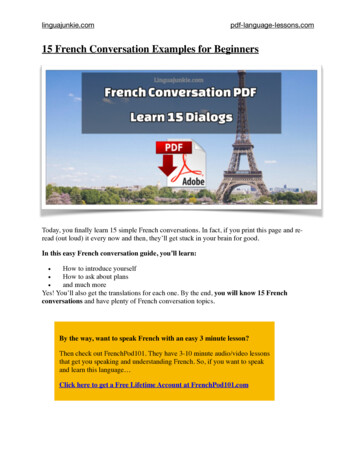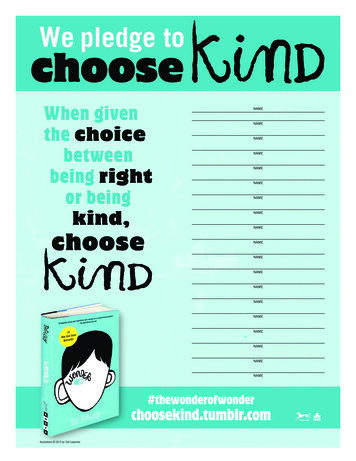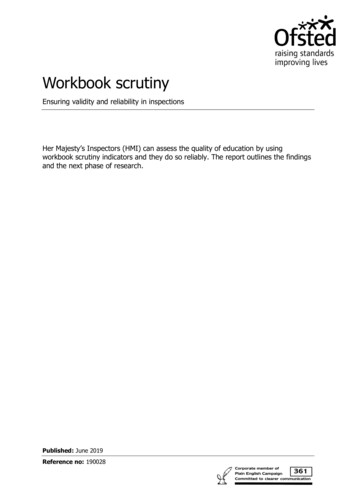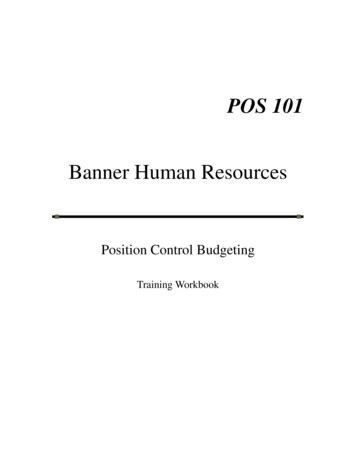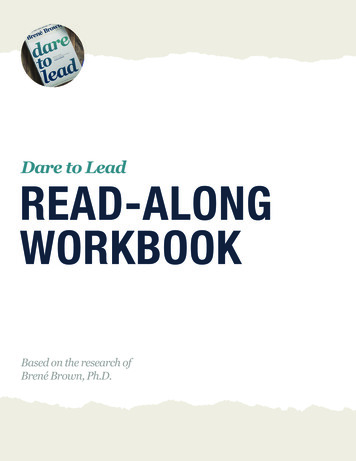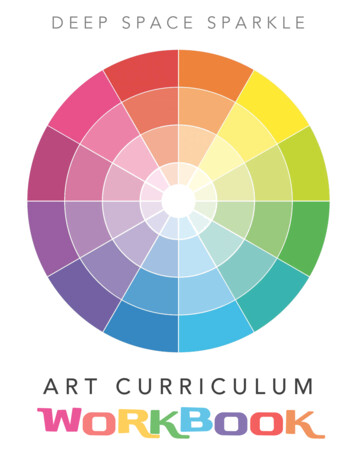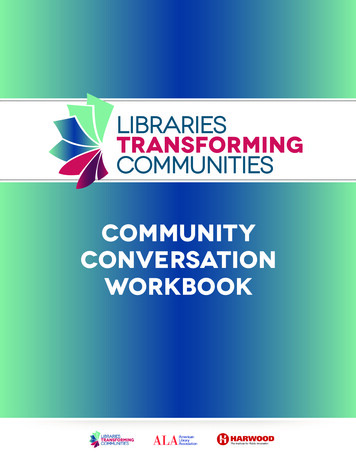
Transcription
CommunityConversationWorkbook
About theinitiativeAbout Libraries Transforming CommunitiesLibraries Transforming Communities (LTC) is an ALA initiative that seeks to strengthenlibrarians’ roles as core community leaders and change-agents. LTC addresses a criticalneed within the library field by developing and distributing new tools, resources, andsupport for librarians to engage with their communities in new ways. As a result, webelieve libraries will become more reflective of and connected to their communitiesand build stronger partnerships with local civic agencies, nonprofits, funders, andcorporations. The initiative is made possible through a grant from the Bill & MelindaGates Foundation.About the American Library AssociationThe American Library Association is the oldest and largest library association in the world,with approximately 58,000 members in academic, public, school, government, andspecial libraries. The mission of the American Library Association is to provide leadershipfor the development, promotion, and improvement of library and information servicesand the profession of librarianship in order to enhance learning and ensure access toinformation for all.About the Harwood InstituteThe Harwood Institute for Public Innovation is a nonprofit that teaches and coachespeople and organizations to solve pressing problems and to change how their communities work together. Based on more than 25 years of innovating with communities, TheHarwood Institute has developed a proven practice used in thousands of communitiesnationally and worldwide.2 #librariestransform
The Value of CommunityConversationsCommunity Conversations serve two importantpurposes: They are a turned-outward way to authentically engage members of the community. They generate Public Knowledge that can then be used to inform decision-makingof all kinds.Engage the community to understand: People’s aspirations for the community. People’s concerns. How people think and talk about a given issue in relation to the community. The changes needed to reach our aspirations for the community. What people believe we can do, and who they’d trust to take action.Community Conversation themes help inform how you: Engage the community: Inviting new people opens the door to new relationships. Find new partners: Sharing Public Knowledge creates coalition opportunities. Develop strategies: Working on the issue AND building capacity to work together. Mobilize resources: Creating natural pathways for people to contribute.#librariestransform 3
PublicKnowledgeThe value of Public Knowledge: Roots your work and decisions in what matters to people. Identifies key issues and their connections in language that people use. Uncovers a sense of common purpose. Enables you to set realistic goals. Informs your choices so your work is more relevant and has greater impact. In most communities, few leaders or organizations HAVE Public Knowledge. Too often we substitute expert knowledge for Public Knowledge.Public KnowledgeExpert KnowledgeComes from engaging with peoplearound their aspirations, their concerns,how they see their community.Comes from professional analysis andreporting of statistics, trend data, polldata, market and audience studies.In plain language that everyone canunderstand.Often in language that onlyprofessionals understand.Notes4 #librariestransform
Planning theConversationThe ideal size for these conversations is between 8 and 15 people. To get that many, inviteat least 20 people, as some will be unable to make it. If fewer than 8 show up, that’s fine. Goahead. It’ll be worth your time. If more than 20 show up, consider breaking into two groups.Decide whom to inviteThese conversations are a powerful way to get to know different parts of the communityor learn from voices not usually heard. Think about what you want to learn. Do you wantto get a general understanding of how people see the community? If yes, then invite abroad group of people to come and talk. This is a great starting point. Maybe you wantto get a better sense of how a specific group of people or people from a certain part oftown think and talk about their community. Then you will want a more targeted strategy ininviting people. Any of these options is fine. No matter what you choose, remember sincethese are conversations, not rigorous academic research, you do not need a random ordemographically representative sample.After you’ve identified whom you want to engage, think about the individuals or groups whocould help you reach those people. Ask yourself: Who knows the part of the community or the people we want to talk to?»» Staff, volunteers, board members»» Partners and their staff Who already brings people together? Think about asking for help from:»» Local businesses: barber shops, beauty parlors, diners»» Religious leaders, congregations, choirs, prayer groups»» Book clubs, gardening groups, parenting groups, neighborhood associations»» Groups like YMCA, Rotary, the PTA, unionsTips for getting people to come Invite people personally and encourage your staff and partners to do the same. Contact people on your email lists or via social media. Ask people to suggest others to invite (friends, neighbors, peers). Set clear expectations in the invitation. (See next page.) Follow up by email or phone to determine how many people are coming. When possible, try to invite people at least two weeks before the event.#librariestransform 5
SettingExpectationsSetting realistic expectationsAs you invite people to the conversations, it is important to set clear, realistic expectations.These are different from the conversations most groups hold, so it is helpful to explain whatthese conversations ARE and what they ARE NOT.First, what these conversations are: Ninety-minute to two-hour conversations that help us better understand thecommunity and how we can restore our belief that we can get things done together. Focused on learning. We pledge to follow up with you after the conversation to sharewhat we’ve learned and how we will use that information.Secondly, what these conversations are not: A town hall, academic research or a focus group. They are conversations. Sponsored by a political party, a business development effort, etc. About trying to sell a particular solution or approach A gripe sessionSuggested Community Conversation invitation templateWe are hosting a Community Conversation at (location) from (start time to end time)on (date) . (IF YOU HAVE A PARTNER HELPING YOU, BE SURE TO MENTION THEMHERE.)This conversation is one of several that we’ll be having with people across the community.Each one is a chance for us to better understand people’s aspirations for their community,the concerns they have and what they believe might make a difference in strengthening thecommunity. We’ll take what we learn from these conversations and use it to help make ourwork in the community more effective.We can’t promise the conversation will lead to a new program or policy. We pledge to getback to you with what we learned and let you know how we’ll use what we heard.Hopefully you’ll be able to join us. If so, please RSVP to (person) at (contact info) sowe can be sure to have enough refreshments on hand.Thank you.PS. For more information don’t hesitate to contact (person) at (contact info) .6 #librariestransform
Where to HoldCommunity ConversationsSite location can have a big impact on the success of your Community Conversation. Thesetting can affect who attends each Community Conversation, the quality of the conversationand the group’s ability to get its work done. Ensure that the invited participants will be comfortable in the chosen location.Look for a place that: Folks are familiar with and use frequently. Is considered to be part of the community. Usually this excludes government or“official” places and schools. Has a second or third room available if you need to divide up a large group. Is available in the evenings and/or on weekends. Offers a comfortable environment. Is not too noisy or full of distractions. Is easily accessible to all participants: plenty of parking, centrally located, safe, nearpublic transportation, accessible to those with disabilities. Is affordable given project resources.More and less desirable places to look for sitesHere are some examples of both more and less desirable places for the CommunityConversations. This is not an exhaustive list; think about other potential sites for theCommunity Conversations in your area.More DesirableLess DesirablePublic librariesCity hallCommunity centersGovernment buildingsPlaces of worshipSchoolsCommunity organizations (YMCA, etc.)Fancy hotelsRecreation centersOffice buildings (especially after hours)#librariestransform 7
Traits ofConversation LeadersThe responsibility of a Conversation LeaderThe main responsibility of a Conversation Leader is to create an environment that enables youto learn about the community and people’s aspirations. It’s more than just running a meeting.Good Conversation Leaders are curious listeners, focused on creating a conversation wherepeople can discover and learn from one another and explore their own ideas.An effective Conversation Leader: Remains neutral about the topic under discussion; is not seen as having his or her ownagenda or siding with one group. Explores ideas with people; displays a genuine sense of curiosity. Listens to people and builds trust. Pushes people to consider different perspectives, helping folks to understand whyothers think in different ways. Helps people reconcile conflicting remarks in a non-confrontational manner. Has experience leading or facilitating group discussions. Stays focused on the goal of the conversation — this is about learning, not promotion. Prepares for each conversation by reading the guide and going over notes fromprevious conversations.Note: Conversation Leaders do not need to be experts on these issues. They are thereto guide, not participate in, the conversations.8 #librariestransform
Tips for LeadingConversationsTo get the most out of the conversation, you want to go beyond people’s surface reactions.Here are several rules of thumb to use when leading these conversations:Take nothing at face value:Notice the words and phrases people use. Probe byasking, “What do you mean?” and “What are yougetting at?”Listen for wherepeople get stuck:Watch for places where people need more facts orwhere a perception prevents them from saying moreabout a concern.Engage people early on:Make sure everyone says something early on. Askpeople what they think about what others are saying.Ask people to squaretheir contradictions:Illuminate what folks are struggling with. Ask, “I knowthis can be a really tough issue, but how do the twothings you said fit together?”Keep juxtaposingviews and concerns:Help keep theconversation focused:Piece together whatpeople are saying:Keep in mind the“unspoken” rules:Watch out for your ownpreconceived views:Pointing out contrasts will help people articulate whatthey really believe and give you a deeper understandingof what they think.Help people stay focused. Remind participants whatthey are discussing. Don’t let things get too far afield.Folks won’t make one all-inclusivestatement about what they think. Say,“This is what I’m hearing. Do I have it right?”Different conversations and spaces have their own setsof “rules.” Check the level of trust people have and whatit means for how you should interact.Everyone has biases that can filter our questions andinterpretations. Be alert to them.#librariestransform 9
Tips for LeadingConversationsTroubleshooting GuideIFTHENA few people dominate theconversationEngage each person from the start. Make sureeveryone says something early on. Ask, “Are thereany new voices on this issue?” or “Does anyoneelse want to jump in here?” Be direct and say, “Weseem to be hearing from the same people. Let’s giveothers a chance to talk.” Call on people by name toanswer.The group gets off on atangent or a person rambleson and onAsk, “How does what you’re talking about relateto our challenge?” or “What does that lead you tothink about (the question at hand)?” Ask them torestate or sum up what they said in a few words.If you can’t get a person to focus, interrupt him/her when they take a breath and move to anotherperson or question. Then bring him/her back intothe conversation later.Someone seems to havea personal grudge aboutan issue and keeps talkingabout itRemind the person where the group is trying tofocus. Ask him/her to respond to the question athand. Acknowledge the person and move on. Say,“I can understand where you are coming from, butwe need to move on.” If the person continues to bedisruptive, interrupt them. Say, “We heard you, butwe’re just not talking about that right now.”People argueDon’t let it bother you too much — it’s okay as longas it is not mean–spirited. Find out what’s behindthe argument; ask why people disagree, get to thebottom of it. Break the tension with a joke or something funny. Stop to review the ground rules. Take abreak.People never disagree or are“too polite”Play “devil’s advocate.” Bring up or introduce different or competing ideas and see how peoplerespond. Tell the group you’ve noticed that theydon’t disagree much and ask if everyone is really inas much agreement as it seems.10 #librariestransform
Ground Rules1. Have a “kitchen table” conversationEveryone participates; no one dominates.2. There are no “right answers”Draw on your own experiences, views and beliefs. You do not need to bean expert.3. Keep an open mindListen carefully and try hard to understand the views of those who disagreewith you.4. Help keep the discussion on trackStick to the questions; try not to ramble.5. It is okay to disagree, but don’t be disagreeableRespond to others how you want to be responded to.6. Have fun!#librariestransform 11
Setting up theConversation1. Introductions Introduce yourself. Thank any groups or individuals involved in setting up the conversation. Thank the participants for coming.2. Set expectations Over the next few months, we will be holding conversations like this one with peopleacross town to talk about their aspirations, their concerns and how we can move forward. Tonight’s conversation is a chance for us to better understand how you see things inour community. We can’t promise to create a new program based on this conversation. We will promiseto get back to you with what we learn tonight and how we’ll use it. These conversations usually last between 90 minutes and two hours, though sometimesfolks want to talk more.3. Review the ground rules Go over the ground rules. Ask, “Do those rules work for everyone?”4. Explain your role as a Conversation Leader Tonight, my role is to ask questions that help us have a good conversation. I won’tparticipate or offer my views – this is a conversation about what you think. To be sure I get what you’re saying, I may ask follow-up questions or play “devil’s advocate.” To make sure we hear from everyone, I may ask you to hold off on comments at times.5. Identify the Note-taker We have someone (point them out) taking notes tonight. The notes won’t includeanyone’s name or be made public; they’re to make sure we catch what you’re saying.6. Get started Before we get started, please tell us your first name, where you live and what youlike to do in your free time.12 #librariestransform
Questions1. What kind of community do you want? Why is that important? How is that different from the way things are now?2. Given what we just said, what are the two or three most important issueswhen it comes to the community? Decide which issue is most important for the group and use it for the discussion. If you are going to test a specific issue, introduce it here. How about,how does that fit with what we’re talking about? What concerns do you have about that?3. What concerns do you have about this issue? Why? Does it seem like things are getting better? Worse? What makes you say that? How do you think the issue/concern came about?4. How do the issues we’re talking about affect you personally? What personal experiences have you had? How about people around you – family, friends, coworkers, neighbors, others – what doyou see them experiencing? Are some people affected more than others? Who? In what ways? Why?5. When you think about these things, how do you feel about what’s going on? Why do you feel this way? How do you think other people (in different parts of town) feel about this?6. What do you think is keeping us from making the progress we want?#librariestransform 13
Questions, cont.7. When you think about what we’ve talked about, what are the kinds ofthings that could be done that would make a difference? What do you think these things might accomplish? How about in terms of individuals: What are the kinds of things that people like uscould do to make a difference? What’s important for us to keep in mind when we think about moving ahead?8. Thinking back over the conversation, what groups or individuals would youtrust to take action on these things? Why them and not others?9. If we came back together in six months or a year, what might you see thatwould tell you that the things we talked about tonight were starting tohappen? Why would that suggest things were changing? What would it mean to see that?10. Now that we’ve talked about this issue a bit, what questions do you haveabout it? What do you feel you’d like to know more about that would help you make bettersense of what’s going on and what should be done? What kind of follow-up would you like out of this discussion?14 #librariestransform
The Role ofNote-takerThe main responsibility of a Note-takerThe main responsibility of a Note-taker is to capture key insights, ideas, themes, turning pointsand quotes from the Community Conversation. Note-takers work with Conversation Leaders toidentify themes within conversations and across several conversations.Note: Don’t try to write down everything you hear (it’s not a transcript). Nor should youjust summarize a few points. The goal is to capture details, key quotes, turning points andpatterns that can be used to create themes.An effective Note-taker: Is curious about how people think about the world. Is observant, noting what people say, how they say it (the emotion, tension or doubt)and even what people aren’t saying (what’s being ignored). Captures the essence of the conversation without inserting his/her own voice, wordsor judgment. Is good with details (like the specific words that people are using) AND able to helptranslate that into larger themes. Stays focused on the goal of the conversation: “What are we learning?”Immediately after the conversation, talk with the Conversation Leader to compare notes. Ask: What did you make of the conversation? What ideas, actions or comments really seemed to resonate with the group? What did you notice in terms of the group’s energy and emotion? What quotes stood out for you? What do we need to write down while it’s fresh?Key Step: Be sure to organize your notes. After the conversation, the Note-takershould organize their notes into six categories: Aspirations, Main concerns, Specificissue concerns, Actions, Who people trust and Questions. These categories will becritical for identifying themes and implications later in the process. The goal is to capturedetails, key quotes, turning points and patterns that can be used to create themes.#librariestransform 15
Tips forNote-takingWhat to look and listen for:During conversations, look and listen for these key concepts to help you better understandwhat participants are saying. The goal is not just to hear what participants are saying,but to understand why they are saying it (as well as what they might not be saying).Starting points:Language:Body language:Emotions:Common idden story:Turning points:16 #librariestransformWhat are participants’ initial thoughts and perspectives? How do theirstarting points differ with where they end the discussion?What words do participants use? How is their language distinctive?Are participants engaged or do they hang back?What feelings do participants bring to the table? How strongly do theyfeel these emotions? What emotions prevail in the conversation?Where do folks agree? How strong are these areas of agreement?Where do participants disagree? What is at issue for them?On what issues are participants torn and why?What emotional, factual or perceptual barriers are preventing participants from moving forward? How intractable are these barriers?What issues do participants seem to link together?What are participants not saying? What is going on beneath thesurface that drives what people are saying?Where were you able to break through in the conversation? Whatquestions or issues triggered that?
Note-takingToolUse this note-taking tool during conversations tocapture the key points voiced. Do this carefully. It’scritical to understanding and getting the most out ofthe conversation. Afterward, take the time to talkwith the Conversation Leader to compare insights— this will strengthen your notes.AspirationsMain ConcernsSpecific Issue ConcernsActionsWho People TrustQuestions1. What kind of a community do you want?(Listen for aspirations.)2. Given what we just said, what are the two or three most important issueswhen it comes to the community?3. What concerns do you have about this issue? Why?4. How do the issues we’re talking about affect you personally?(Look for connections people make between ideas.)5. When you think about these things, how do you feel about what’s going on?(Listen for emotions and intensity and for places where people voice a sense of hope.)#librariestransform 17
Note-takingTool, cont.6. What do you think is keeping us frommaking the progress we want?(Listen for barriers in the community or in thenature of relationships.)AspirationsMain ConcernsSpecific Issue ConcernsActionsWho People TrustQuestions7. When you think about what we’ve talkedabout, what are the kinds of things that could be done that would make adifference? (Listen for what gives people hope, who they think could/should act.)8. Thinking back over the conversation, what groups or individuals would youtrust to take action on these things?9. If we came back together in six months or a year, what might you see thatwould tell you that the things we talked about tonight were starting tohappen? (Listen for what gives people confidence, where they see a place forindividuals to act.)10. Now that we’ve talked about this issue a bit, what questions do you haveabout it?18 #librariestransform
OrganizingYour NotesReview and combine your notes from the different conversations. Organize them into sixcategories. It’s okay if these are fairly long or overlap. You want to keep things broad hereso you can see patterns. You’ll be narrowing and clarifying as you go. Have notes in a formthat will be easy for people to access and use (e.g. electronic file they can print and bringwith them).Aspirations (for the community, their children):Main concerns (top-of-mind concerns about the larger community):Specific issue concerns (those concerns related to the issue you’re exploring):Actions that would make a difference:Whom do people trust to act:Questions people have:#librariestransform 19
Community NarrativetemplateOne of the best ways to make sense of what you’re learning and stay focused on the essenceof your Community Conversations is to try to tell a story about what you’re hearing in languagethat people use every day. A clear story combined with personal examples from CommunityConversations is a powerful combination of Public Knowledge you’ll use regularly.Community Narrative TemplatePeople want (aspirations) , but they’re concerned that (main concerns) .As people talk more about those concerns they talk specifically about(specific issue(s)) . They believe we need to focus on (actions) and if(groups) played a part in those actions that folks would be more likelytrust the effort and step forward.20 #librariestransform
Getting Started withConversationsHolding your first Community ConversationThe most important step you can take here is to get out into the community and getstarted. Use your first conversation as a way to build up momentum and get your feet wet.For the first conversation: Where can we get started? Where could we hold a conversation and simply get a feel for what these are like, andget moving?Potential locations for thefirst conversationPerson responsible foridentifying locationGroups/individuals to help recruitfor our first conversationConversation LeaderNote-taker(s)Person responsible forrecruitmentPerson responsiblefor coordinatingFinalize locationby (date)Finalize recruitmentplan by (date)Finalize leader andNote-taker by (date)#librariestransform 21
community conversationworksheetUse this worksheet to pull the key details behind hosting conversations into a single place.The conversation will be with:(for more on this see page 5)The conversation will be held:(for more on this see page 7)TIME:PLACE:The Conversation Leader is:(for more on this see page 8)The Note-taker is:Tips Arrive one hour early. Leave time to set upthe room before people arrive. Put up signs to direct people from the mainentrance to the meeting room. Have a sign–in sheet for participants. Havepeople fill this out before the conversation.Supplies Extra pens/pencils Name tags and tabletents Sign–in sheets Paper to make signs The room should be well–lit, not too bright.Make sure the room is a comfortable temperature. Charts and easels(if needed) Make sure the room has tables. Tables signalwe’re doing work, and it’s easier to take notes. Refreshments Provide blank name tents for people to writetheir name. Encourage folks to use first names. Put refreshments in a location easily accessedwithout interrupting the discussion. Find the restrooms so you can tell people wherethey are before the discussion begins.22 #librariestransform Copies of the groundrules
Follow-upCommunicationsSuggested template for follow-up communicationsThank you for coming to the Community Conversation on (date) .We appreciate you sharing your time and insights. As promised, we wanted to share withyou what we heard and learned and how we’re thinking about using that moving forward.From the conversation it seems like people want (aspirations for the community) butright now (concerns) make that difficult. It was also clear that people believe there aresteps we can take – things like (actions) . Does that fit with how you saw the conversation?Moving forward, we are going to pull together what we’re hearing and learning fromdifferent conversations and we will (how you are going to use what you’ve heard) .Thank you again for taking time to come to the conversation. We’d love to stay in touch aswe move forward.If you have any questions about the conversation or our work, don’t hesitate to call(person) at (phone) .Sincerely,(Name)(Organization)#librariestransform 23
Ninety-minute to two-hour conversations that help us better understand the community and how we can restore our belief that we can get things done together. Focused on learning. We pledge to follow up with you after the conversation to share what we’ve learned and how we will use that information




